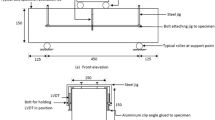Abstract
This study deals with the determination of uniaxial tensile strength of concretes reinforced withA-fibres (slag-basalt fibres) and glass-fibres at the age of 0,3 and 6 hours. For the determination of the tensile strength of fibre-reinforced concrete in its early age of setting and hardening a method was applied which was developped for the investigation of plain concretes.
Tests were performed to obtain the relationships between the fibre volume fractions and uniaxial tensile strengths of concretes at different, ages. The kinetics of strength increase has been studied. It is shown that the kinetics of strength increase is to a high degree dependent on the kind of fibre reinforcement.
Résumé p Les essais effectués par l'auteur ont montré que l'appareillage construit pour l'étude de la résistance en traction des bétons ordinaires aux toutes premières heures du durcissement convenait à l'étude des bétons armés de fibres. Les résultats ont montré que l'accroissement de résistance à la traction à l'étape initiale du durcissement dépend fortement du type de fibre.
Dans le cas de fibres A (laitier basaltique), la résistance à la traction des bétons armés par 3,5% de fibres en volume était, à toutes les étapes du durcissement (0,3 et 6 heures), à peu près de 2 k Nm−2 supérieure, à celle des bétons contenant 1,25% de fibres. Par rapport à la matrice béton, le gain est de 4 kNm−2 pour les bétons armés de 3,5% de fibres à 3 heures aussi bien, qu'à 6 heures.
Dans le cas de bétons armés de fibres de verre, le gain de résistance n'est plus constant en fonction du temps, la différence de résistance entre les bétons ayant le plus faible pourcentage volumique de fibres, 0,75%, et le plus élevé, 2,5%, croît avec l'âge du béton. Les différences observées sont de 2 k Nm−2 à 3 heures et de 7 kNm−3 à 6 heures après coulage. La comparaison entre matrice béton et béton armé de 2,5% de fibres est la suivante: à 3 heures la différence est de 4 kNm−2 et approximativement 13 kNm−2 à 6 heures.
Similar content being viewed by others
References
Rehm G.—Faserbewehrter Beton. Betonwerk+Fertigteil-Technik, Vol. 39, No. 3, 1973, pp. 683–641.
Komloš K.—Faserbewehrter Beton. Tiefbau, Vol. 15, No. 4, 1973, pp. 369–396.
Wischers G.—Faserbewehrter Beton. Beton, Vol. 24, No. 3, 1974, pp. 95–99.
Hilsdorf H. K.—Zementgebundene Matrix und Faserbewehrung. Der. Heidelberger Portländer, No. 2, 1975, pp. 15–19.
Swamy R. N., Mangat P. S.—The interfacial bond stress in steel fiber cement composites. Cement and Concrete Research, Vol. 6, No. 5, 1976, pp. 641–650.
Cuykens T., Venstermans J.—Béton renforcé de fibres en acier. C.S.T.C.-Revue. Bruxelles, No. 3, 1977, pp. 2–19.
Cziesielski E.—Möglichkeiten der Anwendung von Glasfaserbeton im Bauwesen. Der Heidelberger Portländer. No. 2, 1975, pp. 40–44.
Lankard D. R.—Fibre concrete applications. in:Fibre Reinforced Cement and Concrete RILEM Symposium, London, 1975, pp. 3–19.
Halvorsen G. T., Kesler C. E., Paul S. L.—Fibrous concrete for the extruded liner system. Tunnels and Tunnelling, No. 7, 1976, pp. 42–46.
Perkins P. H.—Steel fibre reinforced concrete for sewer pipes. Concrete, Vol. 11, No. 3, 1977, pp. 16–17.
Bayer E.—Stahlfaserbewehrte Betonfahrbahn im Hocheinbau. Tiefbau, Vol. 17, No. 10, 1975, pp. 687–690.
Meyer A.—Erstes Schalendach aus Glasfaserbeton in Deutschland Beton, Vol. 27, No. 4, 1977, pp. 142–148.
Hummert G.—Abwasserrohre aus Stahlfaserbeton. Beton, Vol. 28, No. 3, 1978, pp. 89–90.
Kasperkiewicz I., Skarendahl A.—Bibliography on fibre reinforced and polymer impregnated cement based composites. Cement och Betonginstitutet, Stockholm, 1974, CBI 1:74, 36p.
Swamy R. N.—Fibre reinforcement of cement and concrete. RILEM, Materials and Structures, Vol. 8, No. 45, 1975, pp. 235–254.
Majumdar A. J.—Fibre cement and concrete, a review. BRE Current Paper. CP 26/75, March 1975.
Komloš K.—State-of-the-art report on concrete reinforced with randomly spaced fibres. Stavebnicky casopis, Vol. 25, No. 4, 1977, pp. 263–281.
Fibre concrete materials: A report prepared by RILEM Technical Committee 19-FRC, RILEM, Materials and Structures, Vol. 10, No. 56, 1977, pp. 103–120.
Jejcic D., Zanghellini F.—Mortiers et ciment armés de fibres. Une étude bibliographique. Annales de l'Institut Technique du Bâtiment et des Travaux Publics, 1977. No. 347, Serie: Matériaux, No. 51, pp. 46–87.
Komloš K.—Rheologische Eigenschaften von Faserbetonmischungen. In:Jahrestagung der Deutschen Rheologischen Gesellschaft, Berlin. Mai, 1978.
Komloš K.—Testing of fibre-reinforced concretes in their fresh state. in:International Symposium Testing and Test Methods of Fibre Cement Composites, Sheffield, April, 1978.
Author information
Authors and Affiliations
Rights and permissions
About this article
Cite this article
Komloš, K. Uniaxial tensile strength of early age fibre concretes. Mat. Constr. 12, 201–206 (1979). https://doi.org/10.1007/BF02494251
Issue Date:
DOI: https://doi.org/10.1007/BF02494251




